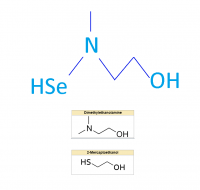I visited the titles of most of the publications listed at human longevity at pubmed http://www.ncbi.nlm....bmed?term=human longevity
While I was looking at longevity genes I found some chemicals or treatments new to me that make mice live 13 pt, 40pt, or twice as long
I urge readers to visit pubmed.org then make a similar list of awesome finds at their preferred areas. It was just an afternoon of reading abstracts.
GI tract bacteria raise longevity
fed L. plantarum CJLP133 and L. fermentum LA12 was 13.89% and 13.69% greater at c elegans
In the current study, the probiotic potential of approximately 350 strains of lactic acid bacteria isolated from Korean infant feces and Kimchi was investigated. Common probiotic properties of the bacterial strains, such as acid tolerance, bile tolerance and adhesion to human intestinal epithelial cells (HT-29 cells), were examined. Some strains were found to have immune modulatory and antimicrobial properties. Antagonistic activity against a panel of pathogenic bacteria was found to be strain dependent. To evaluate the immune modulatory activity of the strains, lymphocyte interferon (IFN)-γ secretion was determined in conjunction with cell proliferation. Some strains of Lactobacillus gasseri, L. fermentum and L. plantarum exhibited increased IFN-γ levels and lymphocyte proliferation. To evaluate the effects of these immune modulating lactobacilli on host life span, Caenorhabditis elegans was used as an in vivo model. Nematodes that were supplied heat-killed lactobacilli as a food source exhibited obvious differences in life span compared with those fed Escherichia coli OP50. The mean life span (determined as mean percent survival) of worms fed L. plantarum CJLP133 and L. fermentum LA12 was 13.89% and 13.69% greater, respectively, than that of control nematodes after 21 days (P=0.036 and 0.043, respectively). In addition, some of safety profiles, including hemolytic type, gelatin hydration and degradation of urea, were found to be positive. These newly identified lactobacilli hold promise for use as probiotic agents, feed additives and/or in food applications.
particular parasites are measured as causing greater longevity
Med Parazitol (Mosk). 2011 Jan-Mar;(1):56-9.
[Increasing the lifespan of a host as one of the survival strategies of parasites].
The paper describes the participation of parasites in the regulation of the physiology of development and reproduction of their hosts. The observed increase in the hosts' lifespan is shown to confer a significant selective advantage for a pathogen in some parasitic systems.
Note similarity to mycorhizzial community benefit
longevity gene
Long-living individuals (LLIs) are used to study exceptional longevity. A number of genetic variants have been found associated in LLIs to date, but further identification of variants would improve knowledge on the mechanisms regulating the rate of aging. Therefore, we performed a genome-wide association study on 410 LLIs and 553 young control individuals with a 317K single-nucleotide polymorphism (SNP) chip to identify novel traits associated with aging. Among the top (p < 1 × 10(-4)) SNPs initially identified, we found rs10491334 (CAMKIV) (odds ratio [OR] = 0.55; 95% confidence interval [CI] 0.42-0.73; p = 2.88 × 10(-5)), a variant previously reported associated with diastolic blood pressure, associated also in a replication set of 116 LLIs and 160 controls (OR = 0.54; 95% CI 0.32-0.90; p = 9 × 10(-3)). Furthermore, in vitro analysis established that calcium/calmodulin-dependent protein kinase IV (CAMKIV) activates the survival proteins AKT, SIRT1, and FOXO3A, and we found that homozygous carriers of rs10491334 have a significant reduction in CAMKIV expression. This, together with the observed reduction in minor-allele carriers among centenarians, points to a detrimental role for the SNP. In conclusion, prolongevity genes are activated by CAMKIV, the levels of which are influenced by rs10491334, a SNP associated with human longevity.
chemical makes mice live 40 pt to twice as long
2 mercaptoethanol makes mice live 40 pt longer as well as doubles the lifespan of a particular kind of mouse at 10-3 m at water
2 mercaptoethanol is very similar to thioclycolate a well known hair modification ingredient
at a variety of references chemical DHEAS is correlated with longevity These genes affect the amount of dheas
Dehydroepiandrosterone sulphate (DHEAS) is the most abundant circulating steroid secreted by adrenal glands--yet its function is unknown. Its serum concentration declines significantly with increasing age, which has led to speculation that a relative DHEAS deficiency may contribute to the development of common age-related diseases or diminished longevity. We conducted a meta-analysis of genome-wide association data with 14,846 individuals and identified eight independent common SNPs associated with serum DHEAS concentrations. Genes at or near the identified loci include ZKSCAN5 (rs11761528; p = 3.15 × 10(-36)), SULT2A1 (rs2637125; p = 2.61 × 10(-19)), ARPC1A (rs740160; p = 1.56 × 10(-16)), TRIM4 (rs17277546; p = 4.50 × 10(-11)), BMF (rs7181230; p = 5.44 × 10(-11)), HHEX (rs2497306; p = 4.64 × 10(-9)), BCL2L11 (rs6738028; p = 1.72 × 10(-8)), and CYP2C9 (rs2185570; p = 2.29 × 10(-8)). These genes are associated with type 2 diabetes, lymphoma, actin filament assembly, drug and xenobiotic metabolism, and zinc finger proteins. Several SNPs were associated with changes in gene expression levels, and the related genes are connected to biological pathways linking DHEAS with ageing. This study provides much needed insight into the function of DHEAS.
people at high altitudes as well as pearl divers might dso well supplementing with dheas
hypoxic Rodents live 3.5 times longer (!!!!!) with dheas yet at that dose normoxic rodents lives slightly less long. They should genetically engineer salmon to make more DHEA to see if they have higher spawning survival from overcoming hypoxia stress
In normoxia, control mice reached the median age of 27 months (median survival: 184 days). Hypoxia not only induced cardiopulmonary remodeling and polycythemia in old animals but also induced severe weight loss, trembling behavior and high mortality (p < 0.001, median survival: 38 days). Under hypoxia however, dehydroepiandrosterone not only significantly reduced cardiopulmonary remodeling but also remarkably extended survival (p < 0.01, median survival: 126 days). Weight loss and trembling behavior at least partially remained, and polycythemia completely, the latter possibly favorably participating in blood oxygenation. Interestingly, at the dose used, dehydroepiandrosterone sulfate was detrimental to long-term survival in normoxia (p < 0.05, median survival: 147 days).
longevity gene
The results show that PON1 gene variants at codon 192 impact on the probability of attaining longevity, and that subjects carrying RR and QR genotypes (R+ carriers) are favoured in reaching extreme ages.
longevity gene
APOE haplotypes are significantly associated with longevity Of note, HP*1/*1 genotype seems to protects APOE*ε4 carriers from age-related negative selection. Collectively, these results also suggest and claim for further investigations on APOE/HP interaction in other age-related diseases such as Alzheimer's disease, atherosclerosis and Parkinson's disease.
longevity gene
Variation in the apolipoprotein E gene (APOE) has been reported to be associated with longevity in humans. The authors assessed the allelic distribution of APOE isoforms ε2, ε3, and ε4 among 10,623 participants from 15 case-control and cohort studies of age-related macular degeneration (AMD) in populations of European ancestry (study dates ranged from 1990 to 2009). The authors included only the 10,623 control subjects from these studies who were classified as having no evidence of AMD, since variation within the APOE gene has previously been associated with AMD. In an analysis stratified by study center, gender, and smoking status, there was a decreasing frequency of the APOE ε4 isoform with increasing age (χ(2) for trend = 14.9 (1 df); P = 0.0001), with a concomitant increase in the ε3 isoform (χ(2) for trend = 11.3 (1 df); P = 0.001). The association with age was strongest in ε4 homozygotes; the frequency of ε4 homozygosity decreased from 2.7% for participants aged 60 years or less to 0.8% for those over age 85 years, while the proportion of participants with the ε3/ε4 genotype decreased from 26.8% to 17.5% across the same age range. Gender had no significant effect on the isoform frequencies. This study provides strong support for an association of the APOE gene with human longevity.
longevity gene
APOE haplotypes are significantly associated with longevity Of note, HP*1/*1 genotype seems to protects APOE*ε4 carriers from age-related negative selection.
longevity gene
large study notes SNP rs4420638 near the APOC1 gene goes with longevity yet is linked to apoe function anyway
(allele-based P=1.8×10(-10)). However, logistic regression analysis revealed that this association, which was replicated in an independent German sample, is fully explicable by linkage disequilibrium with the APOE allele ɛ4 that kind of looks like p<.0000000001 ish
susceptibility or resistance to sudden perishing may go with these genes
We found 14 independent SNPs that predicted risk of death, and 8 SNPs that predicted event-free survival (p < 10(-5)). These SNPs are in or near genes that are highly expressed in the brain (HECW2, HIP1, BIN2, GRIA1), genes involved in neural development and function (KCNQ4, LMO4, GRIA1, NETO1) and autophagy (ATG4C), and genes that are associated with risk of various diseases including cancer and Alzheimer's disease. In addition to considerable overlap between the traits, pathway and network analysis corroborated these findings. These findings indicate that variation in genes involved in neurological processes may be an important factor in regulating aging free of major disease and achieving longevity.
longevity gene
Two polymorphisms (A-3826G and C-3740A), falling in the upstream promoter region of UCP1, were analyzed in a sample of 910 subjects from southern Italy (475 women and 435 men; age range 40-109). By analyzing haplotype specific survival functions we found that the A-C haplotype favors survival in the elderly A-C haplotype upregulates UCP1
longevity effect
We supplemented the diet of 10-month-old Crj:CD-1 female mice with LKM512 for 11 months, while the controls received no supplementation. Survival rates were compared using Kaplan-Meier survival curves. LKM512-treated mice survived significantly longer than controls (P<0.001);
longevity gene
Here we examined the main effects of single loci and multi-locus interactions to test the hypothesis that the adenosine deaminase (ADA) and tumor necrosis factor alpha (TNF-α) genes may influence human life-expectancy when they looked at groups of people of different ages a significant two-loci interaction occurs in females between ADA 22G>A and TNF-α -238G>A
longevity calmness gene
The gene that makes the protein p66(Shc) affects longevity Previous studies have determined that mice with a targeted mutation of the p66(Shc) gene show reduced oxidative stress and extended life span. Deletion of the p66 gene results in an increase in pain threshold and reduced emotionality, differences with wild-type subjects becoming more pronounced with age. Thus reduced oxidative stress throughout the life span is able to prevent some behavioral effects of aging, particularly in response to painful or emotionally arousing stimuli. a calmness longevity gene
centenarians with more zn as well as Se do better thus the gene variants that concentrate these elements may be beneficial
Lithium causes longevity at two different species
In humans, we find here an inverse correlation between drinking water lithium concentrations and all-cause mortality in 18 neighboring Japanese municipalities with a total of 1,206,174 individuals (β = -0.661, p = 0.003). Consistently, we find that exposure to a comparably low concentration of lithium chloride extends life span of C. elegans (p = 0.047).
Taken together, these findings indicate that long-term low-dose exposure to lithium may exert anti-aging capabilities and unambiguously decreases mortality in evolutionary distinct species.
longevity gene
A common polymorphism (rs3851179) in the PICALM (phosphatidylinositol-binding clathrin assembly protein) gene The implication of a genetic variant at PICALM is confirmed for the first time, in centenarians, thus suggesting a possible role in longevity.
mitochondrial gene variant goes with longevity
mitochondrial variant 150T polymorphism (associated with increased longevity) is maternally transmitted
removing a gene that marks proteins to be recycled causes c elegans to live 50 pt longer
ubiquination causes proteins to be noted for protease activity gene variants on this cause c elegans longevity The Machado-Joseph disease deubiquitylase ATX-3 couples longevity and proteostasis.
Protein ubiquitylation is a key post-translational control mechanism contributing to different physiological processes, such as signal transduction and ageing. The size and linkage of a ubiquitin chain, which determines whether a substrate is efficiently targeted for proteasomal degradation, is determined by the interplay between ubiquitylation and deubiquitylation. A conserved factor that orchestrates distinct substrate-processing co-regulators in diverse species is the ubiquitin-selective chaperone CDC-48 (also known as p97). Several deubiquitylation enzymes (DUBs) have been shown to interact with CDC-48/p97, but the mechanistic and physiological relevance of these interactions remained elusive. Here we report a synergistic cooperation between CDC-48 and ATX-3 (the Caenorhabditis elegans orthologue of ataxin-3) in ubiquitin-mediated proteolysis and ageing regulation. Surprisingly, worms deficient for both cdc-48.1 and atx-3 demonstrated extended lifespan by up to 50%, mediated through the insulin-insulin-like growth factor 1 (IGF-1) signalling pathway. As lifespan extension specifically depends on the deubiquitylation activity of ATX-3, our findings identify a mechanistic link between protein degradation and longevity through editing of the ubiquitylation status of substrates involved in insulin-IGF-1 signalling.
glyoxalation gene causes greater longevity
variations on glyoxalase 1 gene affect longevity A component of the glyoxalase system, glyoxalase 1, is a gene with expression influential on lifespan-increasing longevity being associated with increased expression of glyoxalase 1.
Activating AMPK or inactivating calcineurin slows ageing in Caenorhabditis elegans
estrogen restores healing to youthful levels compared with age related version
Estrogen, which substantially decreases with advancing age in both males and females, protects against multiple aspects of cellular ageing in rodent models, including oxidative damage, telomere shortening and cellular senescence. Estrogen's effects are particularly pronounced in the skin where cutaneous changes post-menopause are well documented, and can be partially reversed by classical Hormone Replacement Therapy (HRT). Our research shows that while chronological ageing has clear effects on skin wound healing, falling estrogen levels are the principle mediator of these effects. Thus, both HRT and topical estrogen replacement substantially accelerate healing in elderly humans, but are associated with unwanted deleterious effects, particularly cancer promotion. In fact, much current research effort is being invested in exploring the therapeutic potential of estrogen signalling manipulation to reverse age-associated pathology in peripheral tissues. In the case of the skin the differential targeting of estrogen receptors to promote healing in aged subjects is a real therapeutic possibility.
genes or drugs that reduce brain atrophy cause longevity
[chemical metfomin more effective as longevity drug when taken young [/b]
metformin is more effective with earlier use Treatment with metformin started at the age of 3 months increased mean life span by 14% and maximum life span by 1 month. The treatment started at the age of 9 months insignificantly increased mean life span by only 6%, whereas the treatment started at the age of 15 months failed to increase life span. The mean life span of tumor-free mice was increased by 21% in 'the youngest group', by 7% in 'middle-aged group' and in contrast was reduced by 13% in 'the oldest group'. When started at the age of 3 and 9 months, metformin delayed the first tumor detection by 22% and 25%, correspondingly. Thus, in female SHR mice, metformin increased life span and postponed tumors when started at the young and middle but not at the old age. In contrast, metformin improves reproductive function when started at any age.
extends reproductive life as well as functional survival
noting that dairy cattle as well as humans have longevity effects LEP-R25C, for which the relative risk of culling for cows with genotype CC is 3.14 times higher than for the heterozygous animals not sure if they mean functional lifespan as milk giving span note though that the LEP-R25C gene may be a fertility among humans
gene reduces birth defects has beneficial longevity effects
In eukaryotes, highly conserved Dna2 helicase/endonuclease proteins are involved in DNA replication, DNA double-strand break repair, telomere regulation, and mitochondrial function. The Dna2 protein assists Fen1 (Flap structure-specific endonuclease 1) protein in the maturation of Okazaki fragments. In yeast, Dna2 is absolutely essential for viability, whereas Fen1 is not. In Caenorhabditis elegans, however, CRN-1 (a Fen1 homolog) is essential, but Dna2 is not. Here we explored the biological function of C. elegans Dna2 (Cedna-2) in multiple developmental processes. We find that Cedna-2 contributes to embryonic viability, the morphogenesis of both late-stage embryos and male sensory rays, and normal life span. Our results support a model whereby CeDNA-2 minimizes genetic defects and maintains genome integrity during cell division and DNA replication. These finding may provide insight into the role of Dna2 in other multi-cellular organisms, including humans, and could have important implications for development and treatment of human conditions linked to the accumulation of genetic defects, such as cancer or aging.
















































